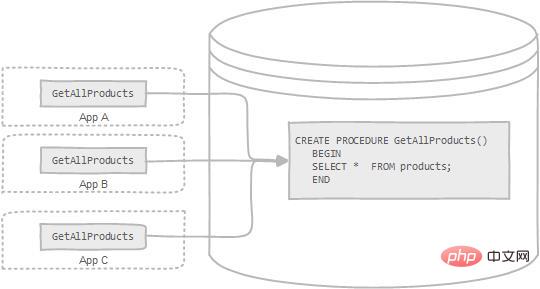What are the advantages and disadvantages of mysql stored procedures
Advantages: 1. Helps improve application performance; 2. Helps reduce traffic between the application and the database server; 3. It is reusable and transparent to any application; 4 , It can improve the security of the database and the integrity of the data; 5. It can make the data independent. Disadvantages: 1. If many stored procedures are used, the memory usage of each connection using these stored procedures will increase significantly; 2. The structure of the stored procedures is not designed for developing complex and flexible business logic; 3. Debugging Stored procedures are difficult; 4. It is not easy to develop and maintain stored procedures.

The operating environment of this tutorial: windows7 system, mysql8 version, Dell G3 computer.
Definition of stored procedure
A stored procedure is a declarative SQL statement stored in the database directory. Stored procedures can be called by triggers, other stored procedures, and applications such as Java, Python, PHP, etc.

The stored procedure that calls itself is called a recursive stored procedure. Most database management systems support recursive stored procedures. However, MySQL does not support it. Before implementing recursive stored procedures in MySQL, you should check the version of your MySQL database.
Stored Procedures in MySQL
MySQL is known as the most popular open source RDBMS and it is widely used by communities and enterprises. However, for the first decade of its existence, it did not support stored procedures, stored functions, triggers, and events. Starting with MySQL 5.0, these features were added to the MySQL database engine, making it more flexible and powerful.
Advantages of MySQL stored procedures
-
Usually stored procedures help improve application performance.
Once created, the stored procedure is compiled and stored in the database. However, MySQL implements stored procedures slightly differently. MySQL stored procedures are compiled on demand. After compiling the stored procedure, MySQL puts it into cache and maintains its own cache of stored procedures for each connection. If the application uses the stored procedure multiple times in a single connection, use the compiled version, otherwise the stored procedure works like a query.
Stored procedures help reduce traffic between the application and the database server because the application must send only the name and parameters of the stored procedure instead of sending multiple lengthy SQL statements .
Stored procedures are reusable and transparent to any application. Stored procedures expose the database interface to all applications so that developers do not have to develop functionality that is already supported in stored procedures.
-
Improve database security and data integrity.
One way to improve the security of stored procedures is to use them as intermediate components. The stored procedures can perform related operations on certain tables, and then the stored procedures are provided as interfaces to external programs. In this way, external programs cannot directly operate database tables and can only operate corresponding tables through stored procedures. Therefore, security can be improved to a certain extent.
-
Make data independent.
The independence of data can achieve the effect of decoupling, that is to say, the program can call stored procedures instead of executing multiple SQL statements. In this case, the stored procedure isolates the data from the user. The advantage is that when the structure of the data table changes, there is no need to modify the program when calling the table. The database administrator only needs to rewrite the stored procedure.
In addition to these advantages, stored procedures also have their own disadvantages that should be noted before using them in a database.
Disadvantages of MySQL stored procedures
If you use many stored procedures, the memory usage of each connection using these stored procedures will be significant. increasing. Furthermore, if you overuse a large number of logical operations in a stored procedure, the CPU usage will increase because the database server is not well designed for logical operations.
The construct of stored procedures is not designed for developing complex and flexible business logic.
Debugging stored procedures is difficult. Only a few database management systems allow you to debug stored procedures. Unfortunately, MySQL does not provide tools for debugging stored procedures.
Developing and maintaining stored procedures is not easy. Developing and maintaining stored procedures often requires a specialized skill set that not all application developers possess. This can cause problems during application development and maintenance phases.
MySQL stored procedures have their own advantages and disadvantages. When developing an application, you should decide whether to use stored procedures based on the application's architecture.
[Related recommendations: mysql video tutorial]
The above is the detailed content of What are the advantages and disadvantages of mysql stored procedures. For more information, please follow other related articles on the PHP Chinese website!

Hot AI Tools

Undresser.AI Undress
AI-powered app for creating realistic nude photos

AI Clothes Remover
Online AI tool for removing clothes from photos.

Undress AI Tool
Undress images for free

Clothoff.io
AI clothes remover

Video Face Swap
Swap faces in any video effortlessly with our completely free AI face swap tool!

Hot Article

Hot Tools

Notepad++7.3.1
Easy-to-use and free code editor

SublimeText3 Chinese version
Chinese version, very easy to use

Zend Studio 13.0.1
Powerful PHP integrated development environment

Dreamweaver CS6
Visual web development tools

SublimeText3 Mac version
God-level code editing software (SublimeText3)

Hot Topics
 MySQL's Role: Databases in Web Applications
Apr 17, 2025 am 12:23 AM
MySQL's Role: Databases in Web Applications
Apr 17, 2025 am 12:23 AM
The main role of MySQL in web applications is to store and manage data. 1.MySQL efficiently processes user information, product catalogs, transaction records and other data. 2. Through SQL query, developers can extract information from the database to generate dynamic content. 3.MySQL works based on the client-server model to ensure acceptable query speed.
 How to start mysql by docker
Apr 15, 2025 pm 12:09 PM
How to start mysql by docker
Apr 15, 2025 pm 12:09 PM
The process of starting MySQL in Docker consists of the following steps: Pull the MySQL image to create and start the container, set the root user password, and map the port verification connection Create the database and the user grants all permissions to the database
 Laravel Introduction Example
Apr 18, 2025 pm 12:45 PM
Laravel Introduction Example
Apr 18, 2025 pm 12:45 PM
Laravel is a PHP framework for easy building of web applications. It provides a range of powerful features including: Installation: Install the Laravel CLI globally with Composer and create applications in the project directory. Routing: Define the relationship between the URL and the handler in routes/web.php. View: Create a view in resources/views to render the application's interface. Database Integration: Provides out-of-the-box integration with databases such as MySQL and uses migration to create and modify tables. Model and Controller: The model represents the database entity and the controller processes HTTP requests.
 Solve database connection problem: a practical case of using minii/db library
Apr 18, 2025 am 07:09 AM
Solve database connection problem: a practical case of using minii/db library
Apr 18, 2025 am 07:09 AM
I encountered a tricky problem when developing a small application: the need to quickly integrate a lightweight database operation library. After trying multiple libraries, I found that they either have too much functionality or are not very compatible. Eventually, I found minii/db, a simplified version based on Yii2 that solved my problem perfectly.
 How to install mysql in centos7
Apr 14, 2025 pm 08:30 PM
How to install mysql in centos7
Apr 14, 2025 pm 08:30 PM
The key to installing MySQL elegantly is to add the official MySQL repository. The specific steps are as follows: Download the MySQL official GPG key to prevent phishing attacks. Add MySQL repository file: rpm -Uvh https://dev.mysql.com/get/mysql80-community-release-el7-3.noarch.rpm Update yum repository cache: yum update installation MySQL: yum install mysql-server startup MySQL service: systemctl start mysqld set up booting
 Laravel framework installation method
Apr 18, 2025 pm 12:54 PM
Laravel framework installation method
Apr 18, 2025 pm 12:54 PM
Article summary: This article provides detailed step-by-step instructions to guide readers on how to easily install the Laravel framework. Laravel is a powerful PHP framework that speeds up the development process of web applications. This tutorial covers the installation process from system requirements to configuring databases and setting up routing. By following these steps, readers can quickly and efficiently lay a solid foundation for their Laravel project.
 MySQL and phpMyAdmin: Core Features and Functions
Apr 22, 2025 am 12:12 AM
MySQL and phpMyAdmin: Core Features and Functions
Apr 22, 2025 am 12:12 AM
MySQL and phpMyAdmin are powerful database management tools. 1) MySQL is used to create databases and tables, and to execute DML and SQL queries. 2) phpMyAdmin provides an intuitive interface for database management, table structure management, data operations and user permission management.
 Centos install mysql
Apr 14, 2025 pm 08:09 PM
Centos install mysql
Apr 14, 2025 pm 08:09 PM
Installing MySQL on CentOS involves the following steps: Adding the appropriate MySQL yum source. Execute the yum install mysql-server command to install the MySQL server. Use the mysql_secure_installation command to make security settings, such as setting the root user password. Customize the MySQL configuration file as needed. Tune MySQL parameters and optimize databases for performance.






